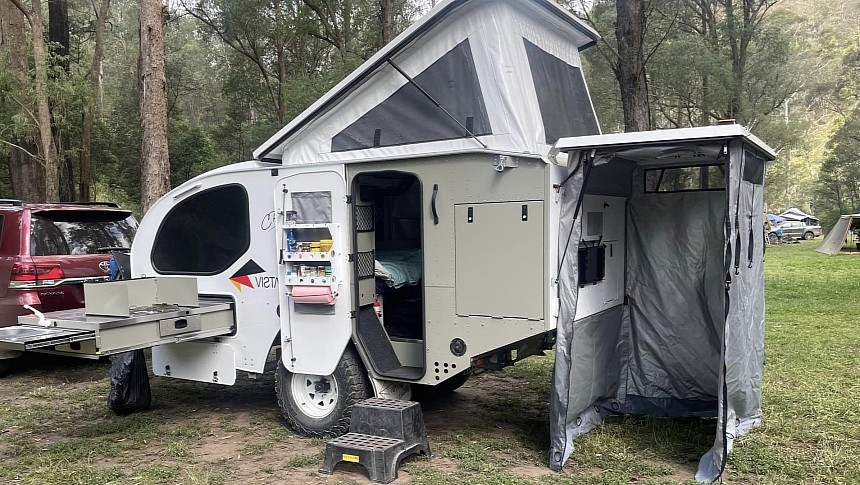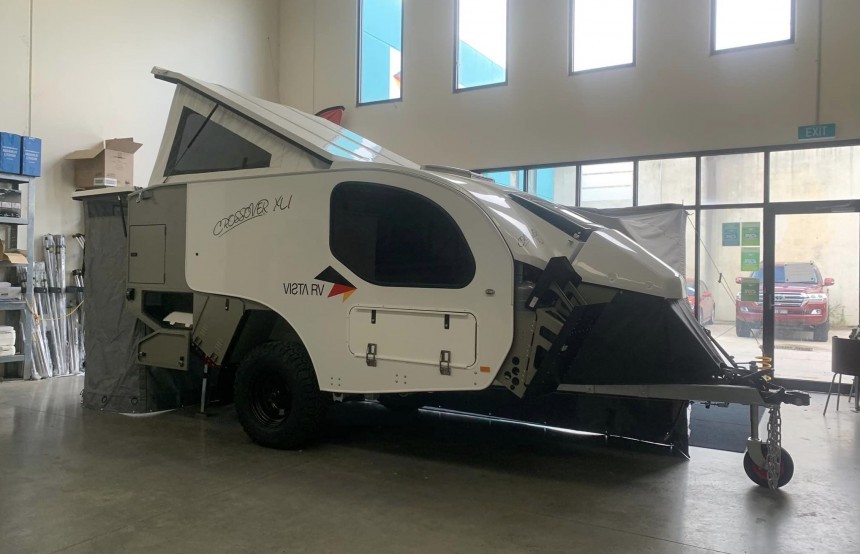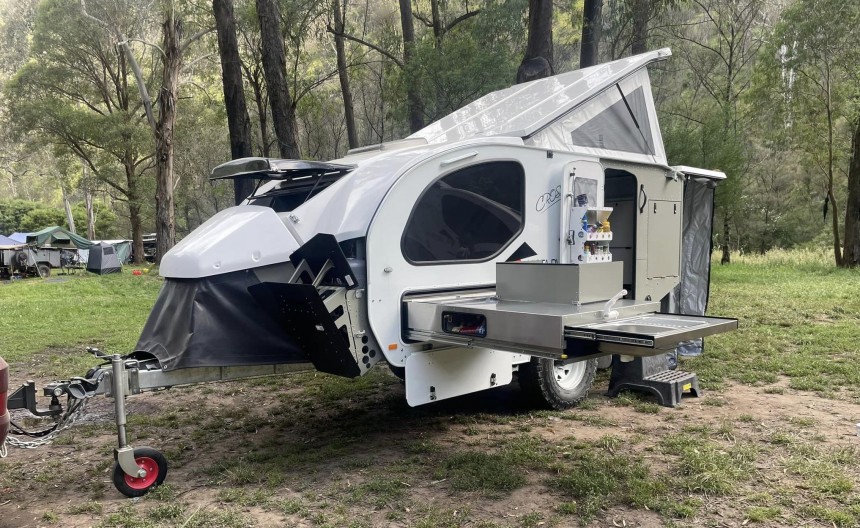While I was searching the world for stand-apart campers and off-grid habitats, I arrived at the one and only nation that's made a name for itself in terms of cranking out incredible on-road living machines, Australia.
It's here that I locked eyes with a crew I'd never met before, Vista RV. Considering I don't live in the land down under, it makes sense for this crew to have flown under my radar, possibly yours too. Well, if you happened to check out the image gallery, then you have some idea of what sort of habitat this crew likes to build. Heck, they've even made a name for themselves with the Crossover design style, and these days, they are responsible for three variations based on customer needs and wants.
Now, to understand precisely what Vista does and why its campers are so dang appreciated, we need to take a look at how they're built. Ever since 2006, Vista has been finetuning and upgrading the shell style you see, in the process, pumping out another two models, the XLE and XLI; the Classic is, well, the Classic, or flagship, if you will.
One aspect of the shells we see is that they're crafted with an array of materials. For example, the roof is good old fiberglass, and so are the sidewalls, but the front and rear caps are solid sheet metal. That's all then set on top of a galvanized chassis, hot dipped, and crafted with a "torsion-rigid system."
But, the most important aspect of the build is the suspension. Vista adds a Crossover MS suspension on each unit, with two bushed control arms that are meant to keep the hub in a vertical plane, removing side and torsion loads. Did I mention these control arms and asymmetric link allows for up to 90 degrees of articulation and "almost eliminate bump steer?" And this stuff has been tested "over 1000's of kilometers across Australia."
With an understanding of what you can do with these babies, let's dive deeper into the sort of lifestyle you can lead with one of these. To do that, let's take a little trip through my imagination. But beware, this one is all about outdoor living in some of the harshest terrains on the planet; don't expect some luxury machine with washing machines, heated mattresses, or carbon fiber accents.
Instead, expect a cozy space where you and your loved ones can brave rogue sandstorms, heavy rains, and high winds and rest their bones after a long day with a pair of kayaks, e-bikes, or scaling local rock faces. Inside, there's a galley block, with capacities depending on the unit you're into, a wardrobe, storage bays, and a modular dinette. But the rest of what you see is all about outdoor living.
After you've got the night's sleep you deserve, you'll find yourself preparing a coffee and breakfast on an exterior galley block that slides out of the Crossover's body. Go ahead, fill the local wilderness with the smell of bacon and some eggs, and then hurry inside to eat your meal before the bears catch on that there are some humans in the area; that always means good eating.
Once you're ready for a new day, the rest of the Crossovers place an outdoor shower and toilet area at your disposal, all integrated into the camper's shell, an awning for shade and kicking back on a pair of lawn chairs, and storage lockers for goods and gear that you may need. The final exterior feature you'll receive as standard is a solar panel, essential for off-grid living. Other than that, it's all up to you to make your Crossover a habitat you can call home.
The question now remains, just how much can you expect to dish out on something like this? Well, it depends on a slew of factors, including the model type, build year, features in store, and the dealership you use to get ahold of your unit. You can find used units for around $60,000 Australian ($40K American) and new units from as low as $80,000 Australian ($54K American). If these babies are as capable as they've been praised, then that's all worth it.
There's just a bit of a catch in all this. Because Vista RV is an Australian crew, they only build campers for this region of the world, meaning that would-be owners from other nations and continents are out of luck. Why? Because Aussieland has different road regulations, build norms, and even power systems can abide by different voltages.
What does this mean for folks like you and me (if you live outside Australia)? It means that the Crossovers will only stand as inspiration for a unit that you pay someone else to build. Why not put the manufacturing processes together and become a brand yourself? Until then, we can drool over a lineup of campers designed to give the flint-and-knife kind of folks that lifestyle they've been looking for.
Now, to understand precisely what Vista does and why its campers are so dang appreciated, we need to take a look at how they're built. Ever since 2006, Vista has been finetuning and upgrading the shell style you see, in the process, pumping out another two models, the XLE and XLI; the Classic is, well, the Classic, or flagship, if you will.
One aspect of the shells we see is that they're crafted with an array of materials. For example, the roof is good old fiberglass, and so are the sidewalls, but the front and rear caps are solid sheet metal. That's all then set on top of a galvanized chassis, hot dipped, and crafted with a "torsion-rigid system."
With an understanding of what you can do with these babies, let's dive deeper into the sort of lifestyle you can lead with one of these. To do that, let's take a little trip through my imagination. But beware, this one is all about outdoor living in some of the harshest terrains on the planet; don't expect some luxury machine with washing machines, heated mattresses, or carbon fiber accents.
Instead, expect a cozy space where you and your loved ones can brave rogue sandstorms, heavy rains, and high winds and rest their bones after a long day with a pair of kayaks, e-bikes, or scaling local rock faces. Inside, there's a galley block, with capacities depending on the unit you're into, a wardrobe, storage bays, and a modular dinette. But the rest of what you see is all about outdoor living.
After you've got the night's sleep you deserve, you'll find yourself preparing a coffee and breakfast on an exterior galley block that slides out of the Crossover's body. Go ahead, fill the local wilderness with the smell of bacon and some eggs, and then hurry inside to eat your meal before the bears catch on that there are some humans in the area; that always means good eating.
The question now remains, just how much can you expect to dish out on something like this? Well, it depends on a slew of factors, including the model type, build year, features in store, and the dealership you use to get ahold of your unit. You can find used units for around $60,000 Australian ($40K American) and new units from as low as $80,000 Australian ($54K American). If these babies are as capable as they've been praised, then that's all worth it.
There's just a bit of a catch in all this. Because Vista RV is an Australian crew, they only build campers for this region of the world, meaning that would-be owners from other nations and continents are out of luck. Why? Because Aussieland has different road regulations, build norms, and even power systems can abide by different voltages.
What does this mean for folks like you and me (if you live outside Australia)? It means that the Crossovers will only stand as inspiration for a unit that you pay someone else to build. Why not put the manufacturing processes together and become a brand yourself? Until then, we can drool over a lineup of campers designed to give the flint-and-knife kind of folks that lifestyle they've been looking for.















